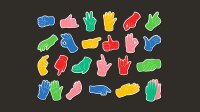Making Classroom Participation More Equitable With Hand Gestures
Not all students feel comfortable participating verbally in class discussions, and these tools invite everyone to contribute.
Your content has been saved!
Go to My Saved Content.As teachers, we can ensure that “all means all” by introducing, modeling, and providing opportunities for students to use hand signals or gestures in the classroom. Gestures are a tool that can support equitable classroom participation by increasing engagement and allowing us to read the room to assess who understands a concept and tailor instruction accordingly.
When teachers ensure that all students are responding, we show that we value every student and have high expectations for every student to contribute. Gestures can prove helpful during independent, partner, small group, and whole group instruction. Below, I offer ways to implement them.
Using Gestures with Large Groups
When used in whole group situations, hand motions enable every student to respond at once. For example, “Show me with your face and body how the character was feeling at this point” or “Show me with your thumb how well you understood that strategy: thumbs up for ‘I understand completely’ and sideways for ‘I’m getting there.’”
Using gestures is great for all and necessary for some, including quieter students, students with anxiety, multilingual students, and students who communicate without speaking. A student may be hesitant or unable to share with the whole group using words, and a hand motion allows them to express their thinking.
As a result, gestures are a huge equity move.
Assessment and Engagement
When I hold all students accountable for participating, energy and engagement increase. I can take a quick assessment of understanding. For example, “Show me with your fingers how many sounds you heard in that word.” I reteach or scaffold as needed, either in the moment or during conferring or instruction at a later time.
Interactive read-alouds are an excellent time to use gestures. With younger kids, I have students act out the story with their hands, to retell it. Students can turn and talk briefly and use a variety of gestures depending on the question; for example, “Tell your partner the two different perspectives” might allow them to hold one hand flat, palm up for the first perspective and to raise the other hand for the second perspective.
Small Groups
When partners and small groups use gestures, they are more likely to bounce ideas off each other. For example, when using the American Sign Language (ASL) “agree” motion, one student can encourage their partner to continue and then build upon what their partner said, using the “I have something to add” gesture.
To assess partnerships and small group dialogues, I glance around the room to see which gestures are being used and get a quick idea of how the conversations are going; I can visit students who need coaching or a check in.
I have also seen students use hand motions when working independently to remind themselves to add detail (place one fist on top of the other), focus (hold two hands parallel with palms facing), or try a different strategy or word (start with palm flat then flip it over), showing how these moves become internalized and enhance learning.
Some of My Most-Used Hand Motions
Two of my favorite signals are agree and disagree. A sense of connection builds when classmates and/or the teacher agrees with a student. Teaching the disagree gesture and modeling how to respectfully disagree deepens conversations as we consider different perspectives.
When a listener uses the elaborate gesture, the speaker feels heard and is encouraged to say more or clarify. The speaker responds with more precise language, an important communication skill. By modeling and asking students to paraphrase, we teach one of the most important listening skills. In order to paraphrase, a listener needs to deeply listen and rephrase to summarize what has been said.
When teaching sound articulation, teachers ask students to point to where sounds are articulated to help students distinguish phonemes, for example: “say /th/ and point to your tongue between your teeth or feel the vibration in your throat.” One of my colleagues teaches or asks her kindergarten students to make a gesture for important high-frequency words; they love to show me their gestures as they warm up by reading the words.
When I introduce sentence stems, I emphasize certain words. For example, when using “I think this strategy is the best because ___,” students use a flat hand extending out from their bodies with the word because. Recently, I saw a teacher use a connect signal with students to show how facts in nonfiction reading connect. As soon as she introduced it, students honed in on the instruction.
Supporting Classroom Culture
In addition to ensuring that all students have the tools to communicate and respond, we can use hand signals to keep instruction flowing. A student using the ASL signal for bathroom allows a teacher to know they are heading to the bathroom without having to stop instruction. Similarly, if a student needs to reset and reflect on classroom expectations, the teacher can give an inconspicuous letter R signal.
Start simple with gestures and introduce them with a sense of playfulness and a clear expectation that all will participate. Then, over time, go deeper and layer on complexity. Be responsive to what students need next. This will increase a sense of novelty and new learning. Using hand motions is such a powerful teaching move, a huge equity tool, and a way to increase engagement.
